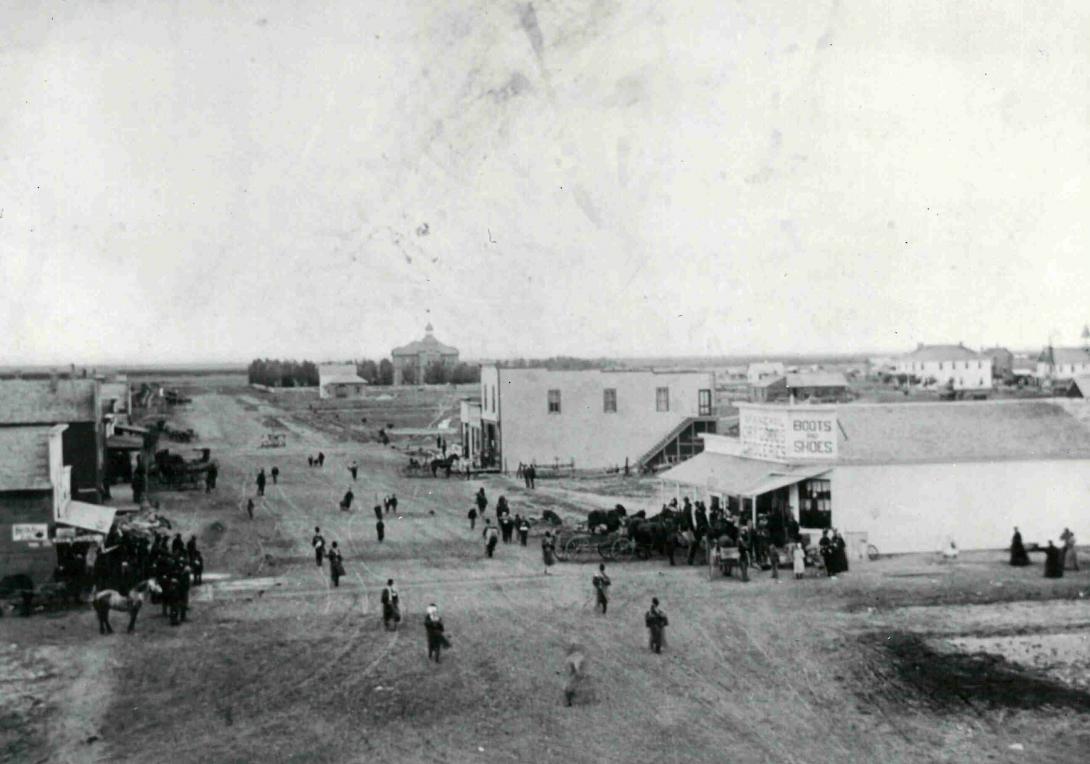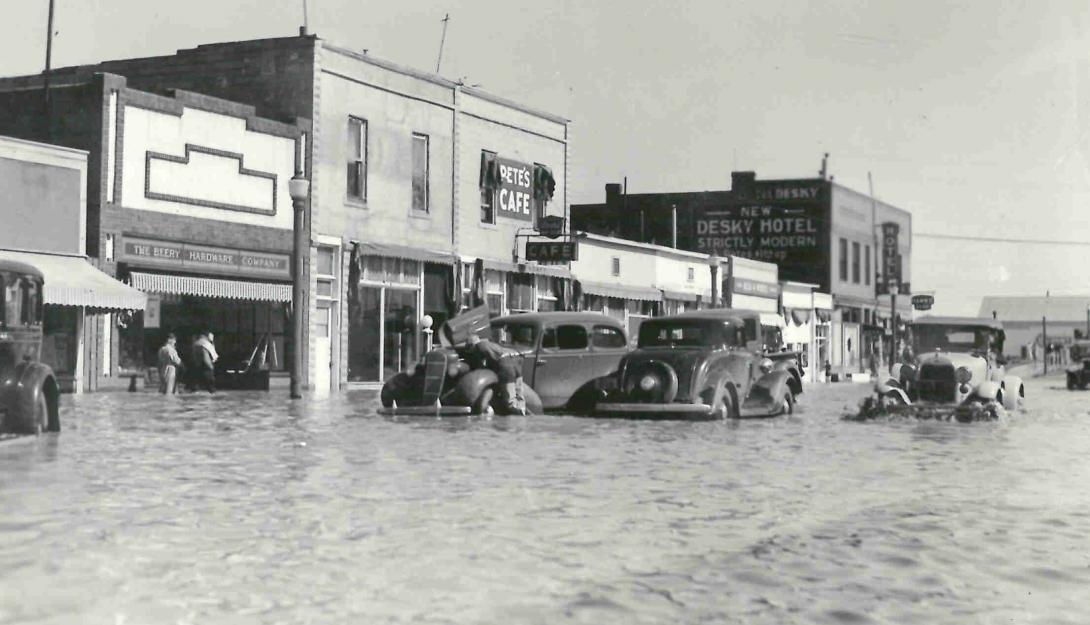Brush
Full Article
Brush is an agricultural community in Morgan County on the plains of eastern Colorado. It is located just east of Fort Morgan at the convergence of US Highway 34, US Highway 6, and State Highway 71 and is situated along the historic Texas Montana Trail. This trail allowed ranchers to graze their cattle on the rich prairie grasses and was the impetus for the town’s organization in 1882.
A harsh winter in 1886–87 (known as “The Great Die Up”) killed the open-range cattle industry, but the waters of the South Platte River ensured that Brush would endure as an agricultural town. By 1900 Brush had become an important rail stop between Denver and Chicago. The sugar beet industry and energy development sustained the town through the twentieth century, and today it is home to approximately 5,500 people.
Early History
Northeast Colorado has a long history of human occupation, mostly by hunter-gatherer societies. People belonging to what archaeologists call the Upper Republican and Itskari cultures left evidence of hunting, fishing, and horticulture along the South Platte corridor in what is now northeast Colorado and Nebraska. By the time European Americans arrived in the second half of the nineteenth century, Cheyenne and Arapaho people hunted bison and found fuel and shelter in the cottonwood groves along the South Platte. The US government eventually forced these people off their land after a series of treaties and violent encounters, including the Sand Creek Massacre of 1864.
Town Formation
Brush is named for Jared L. Brush, an Ohio native who became an important cattle rancher in northeast Colorado and helped to pioneer the cattle trail to Missouri. He was also an important civic leader in nearby Greeley, a Weld County sheriff, a Colorado assemblyman, and a two-time lieutenant governor. While he owned land that would later be used to build the cemetery in his namesake town, he never lived there.
Founders first platted the town in 1882 as a stopping point on the Burlington Railroad line between Chicago and Denver. In October 1884, the 100 residents of Brush voted to formally incorporate. One of the oldest surviving houses in Brush, the Nelson House at 322 Clayton Street, dates to this period. Its old-world simplicity and thick limestone walls make it a unique representation of the area’s development.
Between 1882 and 1889, the Burlington Railroad promoted significant growth, and town promoters believed Brush should be the county seat. But the population still lagged behind nearby Fort Morgan. Within a few years, however, Brush’s population swelled, primarily due to the arrival of a large group of Danish immigrants. In all of Morgan County, Danish immigrants would eventually represent only 2 percent of the population, but they substantially contributed to the city of Brush.
Eben Ezer Lutheran Care Center
As in other Colorado towns, tuberculosis patients helped grow the Brush community. In 1903 a Dane, Pastor Jens Madsen, his wife Ane Marie, and a small group of their Lutheran congregation formed a tubercular treatment hospital in Brush. Operating out of several leased houses on Curtis and Carson Streets, their practice quickly outgrew the small buildings. The Madsens purchased thirty-five acres west of Brush, and by 1906 the hospital’s first building, known as the Bethesda building, was complete. This original building was replaced in 1913 by Elim Hospital, a larger administration building with two patient wings. Also on the grounds was the All-Saints Lutheran Chapel (1916), which still stands today.
Despite its remote location, Madsen’s tubercular hospital gained a sterling reputation. Within thirty years, the Institute became so well-respected that the Crown Prince and Princess of Denmark visited for a tour. Today the facility, originally known as the Eben Ezer Care Institute, remains in operation as the Eben Ezer Lutheran Care Center.
Sugar Beets
At the turn of the century, farmers in Morgan County explored a new crop, the sugar beet. In Brush, the Brush Tribune and the Great Western Sugar Company worked together to distribute seeds to farmers. Harvests were low at first due to drought conditions, but by 1904 farmers harvested approximately 3,000 tons of beets in the Brush area. Brush Tribune owner Ed Madison and local businessman A. J. Morey hoped successful crops would convince Great Western to open a processing facility in Brush. One of the main concerns was irrigation for farmers, so the two raised funds to create Jackson Reservoir northwest of Fort Morgan.
The duo’s promotion efforts paid off. Great Western Sugar decided to build a processing facility in Brush in 1906. This large facility provided a much-needed boost to the local economy. Soon farmers could bring as much as 600 pounds of beets per day to the facility for processing. It also inspired nearby Fort Morgan to campaign for its own factory, which it received and is still in operation. A banner harvest in 1906 helped catapult the Brush factory onto the state’s top producers list. Sugar beets became a wildly successful crop in northeast Colorado, and the Brush facility operated until 1955.
Sugar beets changed the demographic makeup of Brush and Morgan County because beets required intensive manual labor. Germans from Russia and Japanese families arrived to work the fields in the early twentieth century. Later, Mexican and Central American immigrants were brought in to work the fields. Today nearly half of Brush’s population identifies as Latino.
The cultivation of sugar beets was at the mercy of the volatile weather on the plains. In 1935 heavy rains caused a severe flash flood in Brush and the streets quickly overflowed, with up to four feet of water in some places. Four people were killed. Cars parked downtown navigated knee-high water and local businesses suffered costly damage. The South Platte would flood intermittently throughout the twentieth century, including a large event in 1965 that sent a thirty-foot, three-mile-wide crest of water through the area.
World War II
In the runup to World War II, dozens of local boys reported to Fort Sill, Oklahoma, for training. Servicemen from Fort Morgan and Brush composed Company K and Company L, respectively. The first Brush native killed in the war was John Reece, who was stationed on the U.S.S. Arizona during the Japanese attack on Pearl Harbor, Hawaii, on December 7, 1941.
During 1944 and 1945, Brush was home to fifty Italian prisoners of war who helped to alleviate the labor shortage in the sugar beet fields. These prisoners lived in the Armory, originally built in 1921, and the guards lived in the Desky Hotel in downtown Brush.
Energy Frontier
By 1953 Brush was home to one of the highest-producing oil wells in Colorado, which helped propel record growth in Morgan County. The Goodall Pipeline Company and the Arapahoe Pipeline Company quickly connected the Brush wells to a network that stretched as far as Nebraska and Kansas. Brush was also a natural gas producer, and 48,000 feet of gas lines made gas available to Brush customers in 1951.
On December 6, 1981, the coal-fired, steam-electric generating station known as the Pawnee Power Plant went online. Before construction, citizens expressed concerns about the factory’s water usage and potential for pollution. The factory is a zero-discharge facility, meaning it does not produce wastewater. There is a 140-acre reservoir on site. Operators Pawnee, and now Xcel Energy have installed several new systems to mitigate the environmental impact and maintain a clean facility. Construction of the original facility cost upwards of $465 million and created dozens of jobs.
Today
In the twenty-first century, the people of Brush have worked diligently on downtown revitalization and historic preservation. In 2014 Brush received the designation of an All-American City by the National Civic League. In 2015 Brush was the recipient of the Small Community of the Year award by the Economic Development Council of Colorado. Agriculture and livestock raising remain the backbone of the local economy, with feedlots and farms covering the outskirts of town as well as meat processing plants. The sugar beet remains an important crop, with farmers sending beets to Fort Morgan for processing.
Healthcare is also a major employer, with the East Morgan County Hospital and the Eben Ezer Lutheran Care Center. Brush also has its own fairgrounds, a small local museum, a golf course at Petteys Park, and a revitalized downtown that features many small businesses and has recently received new streets, sidewalks, lights, and planters.
































